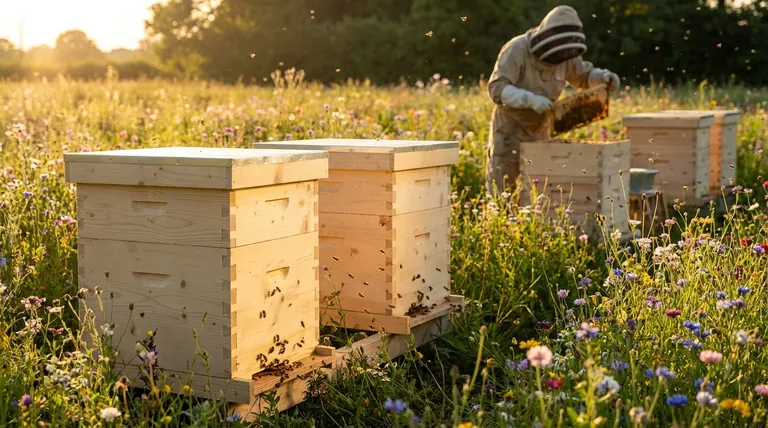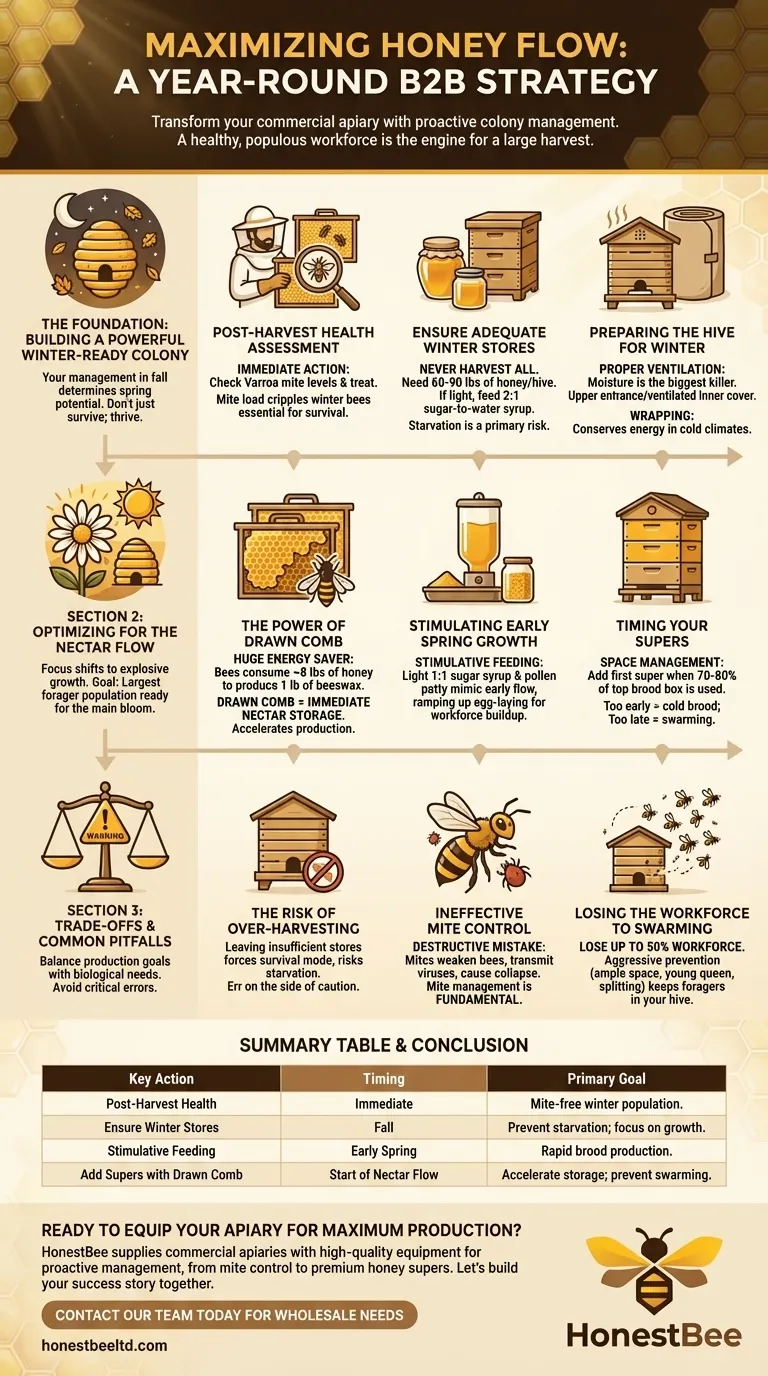Maximizing next season's honey flow is a year-round endeavor that begins the moment you finish this season's harvest. While properly storing your honey supers and drawn comb is an important step, it is just one component of a larger strategy. True maximization comes from ensuring your colony is exceptionally healthy, populous, and ready for work before the main nectar flow even starts.
The most significant factor in maximizing honey production is not what you do during the honey flow, but how you manage the colony's health and population in the months leading up to it. A massive, healthy workforce is the engine that drives a large harvest.

The Foundation: Building a Powerful Winter-Ready Colony
A large honey surplus is a sign of a thriving colony, not one that is simply surviving. Your management practices in the fall and winter directly determine the hive's potential for the following spring.
Post-Harvest Health Assessment
Immediately after you pull the last of your honey, the most critical work begins. A colony that goes into winter weak is unlikely to build up in time for the spring nectar flow.
Your first step is a thorough inspection. Check Varroa mite levels and treat if necessary. A high mite load in the fall cripples the "winter bees" that are essential for the colony's survival until spring.
Ensuring Adequate Winter Stores
Never harvest all the honey. A full-depth hive box requires between 60-90 pounds of honey to survive a cold winter, depending on your climate.
If their stores are light, you must feed them a 2:1 sugar-to-water syrup. Starvation is a primary cause of winter colony loss, and a colony focused on survival cannot build a surplus.
Preparing the Hive for Winter
Proper ventilation is key. Moisture, not cold, is the biggest killer of bees in the winter. An upper entrance or a ventilated inner cover allows moist air to escape.
In colder climates, wrapping the hive can help the bees conserve energy and honey stores, allowing them to emerge stronger and more numerous in the spring.
Optimizing the Hive for the Nectar Flow
As spring arrives, your focus shifts from survival to explosive growth. The goal is to have the largest possible population of forager bees ready to fly the moment the primary nectar sources begin to bloom.
The Power of Drawn Comb
This is where proper storage pays off. Bees must consume roughly eight pounds of honey to produce one pound of beeswax. Giving them drawn comb—frames with the wax foundation already built out—saves them an immense amount of energy.
Instead of spending weeks building wax, the bees can immediately begin storing nectar. This single factor can dramatically accelerate honey production. Ensure frames are stored dry and protected from wax moths and mice.
Stimulating Early Spring Growth
As temperatures rise, you can begin stimulative feeding with a light 1:1 sugar syrup. This mimics an early nectar flow and encourages the queen to ramp up her egg-laying, building the workforce for the main event.
Providing a pollen patty can also be beneficial if natural pollen sources are scarce. Pollen is the protein that bees need to raise new brood.
Timing Your Supers
Adding honey supers is about managing space to both encourage storage and prevent swarming. Add your first super when the bees have drawn out and are using 70-80% of the frames in the top brood box.
Adding supers too early can make it difficult for the colony to keep the brood nest warm. Adding them too late can cause the hive to become "honey-bound," which fills the brood chamber with nectar and can trigger the swarm impulse.
Understanding the Trade-offs and Common Pitfalls
Maximizing honey flow requires balancing production goals with the biological needs of the colony. Miscalculations can lead to a weakened hive or a lost season.
The Risk of Over-Harvesting
It is tempting to take every last drop of honey, but this is a critical error. Leaving insufficient stores forces the colony into survival mode and can lead to starvation if a late-season nectar dearth occurs. Always err on the side of leaving too much honey for the bees.
Ineffective Mite Control
Failing to control Varroa mites is the single most destructive mistake a beekeeper can make. Mites weaken bees, transmit viruses, and cause colony-wide collapse. A colony suffering from a high mite load will never be a strong honey producer. Mite management is not optional; it is fundamental to beekeeping success.
Losing the Workforce to Swarming
Swarming is a colony's natural method of reproduction, but it means you lose up to half your workforce right before or during the main honey flow.
Aggressive swarm prevention—by providing ample space, ensuring a young and productive queen, and sometimes splitting the colony—is essential for keeping those foragers in your hive and working for you.
Your Strategy for a Bumper Crop
Your approach to maximizing honey will depend on your goals and experience level. Focus on the actions that will have the greatest impact on your colony's strength.
- If your primary focus is a simple, high-impact improvement: Obsess over the proper storage and preservation of drawn comb to give your bees a powerful head start next season.
- If your primary focus is consistent, long-term yield: Implement a rigorous, year-round Varroa mite management plan, because colony health is the absolute bedrock of honey production.
- If your primary focus is achieving maximum production: Master the art of spring management to build a massive population that peaks precisely when the main nectar flow begins.
Ultimately, a successful honey harvest is the direct reward for proactive, year-round beekeeping that prioritizes the health and strength of the colony.
Summary Table:
| Key Action | Timing | Primary Goal |
|---|---|---|
| Post-Harvest Health Assessment & Mite Control | Immediately after harvest | Ensure a healthy, mite-free winter bee population. |
| Ensure Adequate Winter Stores | Fall | Prevent starvation; allow colony to focus on growth, not survival. |
| Stimulative Feeding & Population Buildup | Early Spring | Encourage rapid brood production to build a large forager force. |
| Add Supers with Drawn Comb | Just before/at start of nectar flow | Provide immediate storage space to accelerate honey production and prevent swarming. |
Ready to Equip Your Apiary for Maximum Honey Production?
A bountiful harvest starts with the right equipment and strategic planning. HONESTBEE supplies commercial apiaries and beekeeping equipment distributors with the high-quality, durable supplies needed to implement these strategies effectively.
From mite control treatments and feeders to premium honey supers and frames, we provide the tools that support proactive, year-round hive management.
Let's build your success story together. Contact our team today to discuss your wholesale needs and how we can help you achieve your production goals.
Visual Guide

Related Products
- Wholesales Dadant Size Wooden Bee Hives for Beekeeping
- HONESTBEE Professional Long Handled Hive Tool with Precision Cutting Blade
- HONESTBEE Advanced Ergonomic Stainless Steel Hive Tool for Beekeeping
- Professional Multi-Function Stainless Steel Hive Tool
- Honey Flow Garden Bee Hive Flow Hive Best Beehive for Beginners
People Also Ask
- What types of products are available for beekeeping needs? Essential Equipment for Apiaries & Distributors
- What are the characteristics of oil-based paint for beehives? Durability vs. Modern Practicality
- How often should the area under beehives be inspected and cleaned during the warm season? A Proactive Maintenance Guide
- Why were wooden hives traditionally preferred? For Natural Beekeeping Aligned with Bee Biology
- What are the advantages of wooden bee hives? Superior Bee Health & Beekeeper Flexibility



















